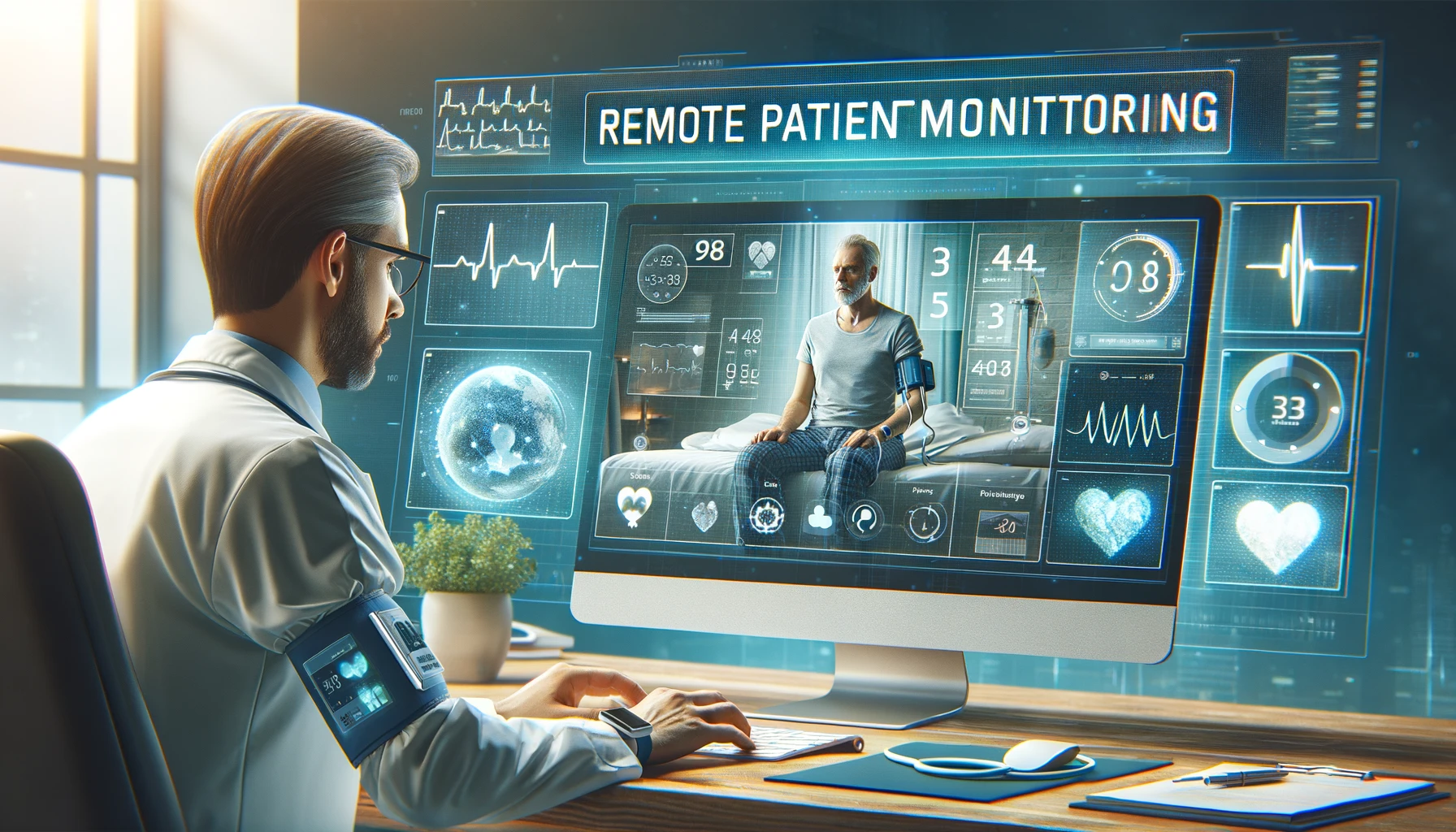Remote Patient Monitoring (RPM)
Definition and Overview
Remote Patient Monitoring (RPM) refers to using digital technologies to monitor and capture medical and other health data from patients in one location and electronically transmit that information securely to healthcare providers in a different location for assessment and recommendations. This innovative healthcare delivery method leverages various forms of technology, including wearable devices, mobile health apps, and telehealth systems, to gather patient data such as vital signs, weight, blood pressure, blood sugar, blood oxygen levels, heart rate, and electrocardiograms.
The Evolution of RPM
The concept of RPM has existed for decades, initially relying on telephone-based reporting and fax machines for data transmission. However, the last two decades have witnessed a dramatic transformation in RPM technologies, spurred by advancements in internet connectivity, smartphone technology, and wearable devices. This evolution has transformed RPM from a rudimentary form of patient monitoring to a sophisticated, real-time data analytics and patient engagement tool. Today’s RPM systems can provide detailed health data, facilitate timely interventions, and offer a level of convenience and efficiency previously unattainable.
The Importance of RPM in Today’s Healthcare
RPM plays a crucial role in modern healthcare by bridging the gap between traditional in-person care and digital health management. It enables continuous care delivery, especially for chronic conditions requiring regular monitoring, without patients needing to leave their homes. This is particularly vital in the context of aging populations and the increasing prevalence of chronic diseases worldwide. RPM enhances patient engagement and adherence to treatment plans, reduces the burden on healthcare facilities, and can lead to better health outcomes at a lower cost. Furthermore, the COVID-19 pandemic has underscored the value of RPM, highlighting its effectiveness in maintaining patient care continuity while minimizing the risk of virus transmission.
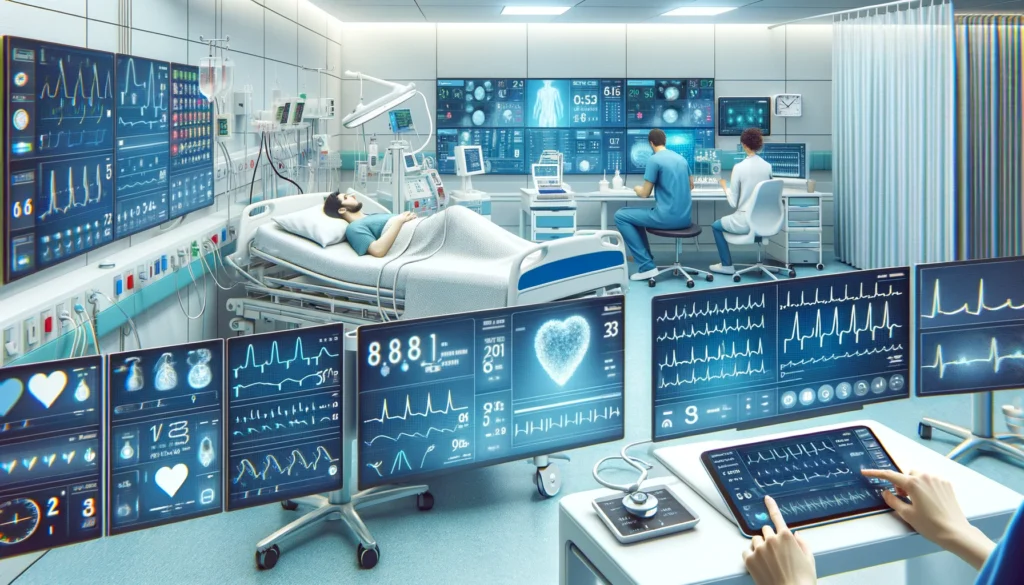
How Remote Patient Monitoring Works
The Technology Behind RPM
RPM technology encompasses a broad spectrum of devices and software. At the heart of these systems are digital monitoring devices that collect health data. These devices can range from wearable gadgets like fitness trackers and smartwatches to specialized medical equipment, such as glucose monitors and blood pressure cuffs. The collected data is then transmitted via the Internet to a software application accessible by healthcare providers. Advanced RPM platforms utilize cloud computing to analyze and store data, employing algorithms to detect anomalies and trends that may require medical intervention.
Setting Up RPM Systems
Setting up an RPM system involves several steps, including selecting appropriate devices tailored to the patient’s health monitoring needs. These devices are configured to securely transmit data to a healthcare provider’s system. Patients are educated on using these devices and the importance of regular monitoring. On the healthcare provider’s side, systems are implemented to receive, analyze, and respond to the data received. This often requires integrating RPM data into electronic health records (EHRs) and setting up protocols for alerting providers to significant health events.
Types of Health Data Monitored
RPM systems can monitor various health data, broadly categorized into vital signs, physiological data, and activity levels. Vital signs monitored include heart rate, blood pressure, respiratory rate, and body temperature. Physiological data might encompass blood sugar levels, oxygen saturation, and electrocardiogram (ECG) readings. Additionally, RPM can track activity levels and patterns, providing insights into a patient’s mobility, sleep quality, and overall physical activity. This comprehensive monitoring capability gives healthcare providers a holistic view of a patient’s health status, allowing for more personalized and timely care.
Vital Signs
- Heart Rate (HR): Heart Rate (HR) is a fundamental measure of heart health, indicating the number of heartbeats per minute. Continuous HR monitoring helps detect arrhythmias, monitor recovery, and assess overall cardiovascular health.
- Blood Pressure (BP) is essential for identifying hypertension and assessing cardiovascular risk. RPM devices for BP allow patients to manage and monitor their condition in real time, reducing the risk of heart disease and stroke.
- Respiratory Rate (RR): The breathing rate per minute is a critical vital sign, especially in patients with respiratory conditions like COPD or asthma. RPM can provide early warning signs of exacerbations or infections.
- Body Temperature: Monitoring temperature remotely can help in the early detection of infections or fevers, which is crucial for patients with immune deficiencies or in post-operative care.
Physiological Data
- Blood Sugar Levels: For diabetic patients, continuous glucose monitoring (CGM) systems play a vital role in RPM, allowing for the adjustment of diet, exercise, and medication based on real-time data.
- Blood Oxygen Saturation (SpO2): This measurement is crucial for patients with respiratory or cardiovascular issues. Pulse oximetry, a non-invasive method, is commonly used in RPM setups to monitor oxygen levels.
- Electrocardiogram (ECG) Readings: ECG monitoring through RPM can detect heart conditions such as atrial fibrillation, heart palpitations, and ischemic episodes, allowing for timely intervention.
Benefits of Remote Patient Monitoring
For Patients
Remote Patient Monitoring (RPM) offers numerous benefits to patients, making healthcare more accessible, personalized, and efficient. By enabling healthcare providers to monitor patients outside of traditional clinical settings, RPM facilitates early detection of potential health issues, reduces the need for hospital visits, and empowers patients with greater control over their health. This leads to improved health outcomes, enhanced convenience, and a better understanding of their health conditions. Additionally, RPM can significantly reduce patient healthcare costs by minimizing emergency room visits, hospitalizations, and readmissions.
For Healthcare Providers
Healthcare providers also stand to gain substantially from RPM. It allows for more efficient resource allocation, enabling providers to focus on patients who need in-person care the most. RPM provides continuous patient health data, offering insights that can lead to more informed decision-making and personalized care plans. This not only enhances the quality of care but also improves patient satisfaction. Furthermore, RPM can help reduce the burden on healthcare facilities by lowering the number of unnecessary visits and hospitalizations.
For Healthcare Systems
At the system level, RPM contributes to healthcare delivery’s overall efficiency and effectiveness. By reducing the strain on healthcare facilities and enabling care for more patients remotely, RPM can help healthcare systems accommodate growing patient populations without the need for proportional increases in physical infrastructure or staff. This scalability is crucial for managing chronic diseases and aging populations. Additionally, RPM can contribute to better health outcomes across populations, reducing overall healthcare costs through prevention, early intervention, and the efficient management of chronic conditions.
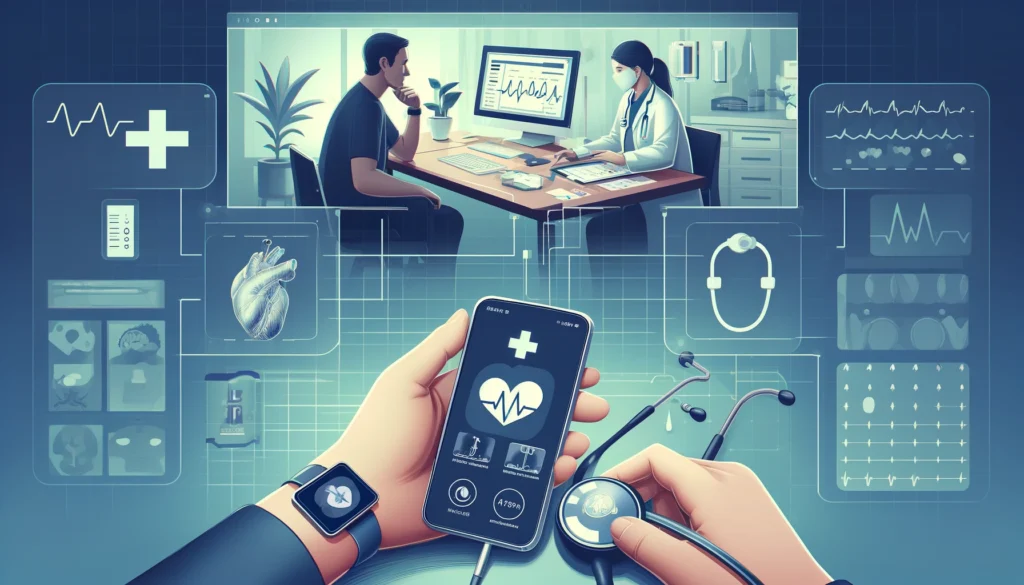
Challenges and Solutions in Remote Patient Monitoring
Technical Challenges and Solutions
One of RPM’s main technical challenges is ensuring the reliability and accuracy of patient health data. Solutions include developing standardized protocols for data transmission and integrating advanced analytics and artificial intelligence to validate and interpret data. Ensuring the interoperability of different devices and systems is also crucial. Universal standards and open platforms can facilitate seamless data exchange between devices from manufacturers and healthcare systems.
Privacy and Security Concerns
Given the sensitive nature of health data, privacy and security are paramount in RPM. Implementing robust encryption methods, secure data storage solutions, and strict access controls can help mitigate these concerns. Additionally, educating patients and providers about data protection best practices is essential. Compliance with healthcare regulations such as HIPAA in the U.S. or GDPR in Europe also ensures that RPM systems adhere to strict privacy and security standards.
Patient Engagement Strategies
Maximizing RPM’s benefits requires active patient engagement. Strategies to enhance engagement include personalized communication, user-friendly technology, and educational programs about the benefits and operation of Remote Patient Monitoring devices. Providing feedback to patients based on their monitored data can also increase engagement by demonstrating the value of their participation in RPM programs.
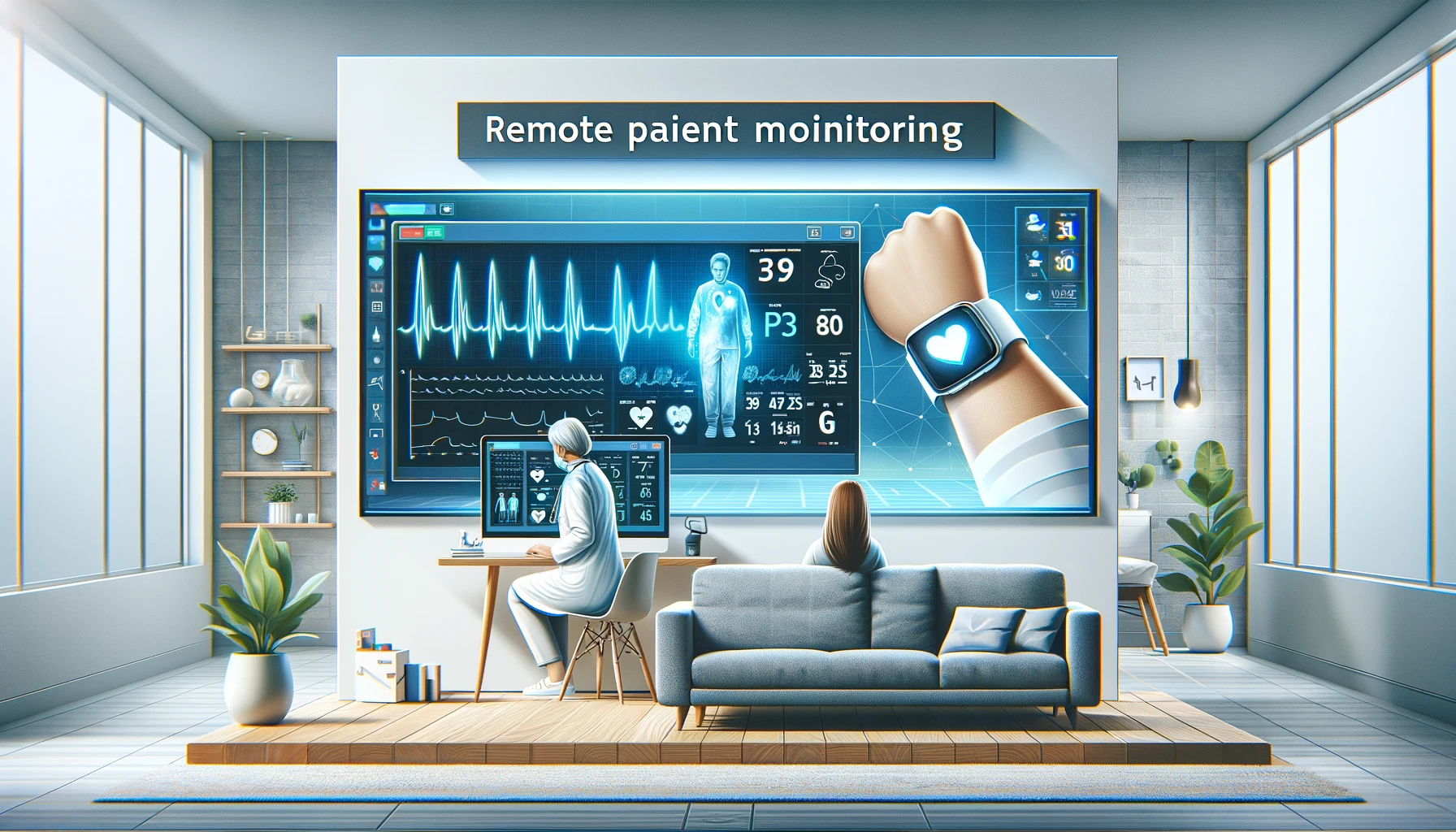
Google’s Role in Remote Patient Monitoring
Google’s Healthcare Initiatives
Google has been increasingly active in healthcare, leveraging its technological prowess to improve healthcare delivery and outcomes. Through projects like Google Health and collaborations with healthcare providers and institutions, Google is working to integrate its advanced data analytics, machine learning, and artificial intelligence capabilities into healthcare applications, including RPM.
Integration of Google Technology in RPM
Google’s technologies, such as cloud computing services, artificial intelligence, and machine learning, are integral to advancing RPM solutions. Google Cloud can securely store and process vast amounts of health data. At the same time, AI and machine learning algorithms can analyze this data to identify trends, predict health outcomes, and provide actionable insights. Additionally, Google’s Android operating system and wearable technologies offer platforms for RPM devices and applications, enhancing connectivity and user engagement.
Future Prospects of Google in RPM
Looking forward, Google will likely continue playing a significant role in shaping the future of RPM. By advancing AI and machine learning technologies, Google can help develop predictive models that personalize care and improve health outcomes. Furthermore, Google’s ongoing research and development in health and wellness, its collaborations with healthcare organizations, and its ability to process and analyze health data at scale position it uniquely to drive innovation in Remote Patient Monitoring, potentially leading to breakthroughs in monitoring and managing health and disease.
Implementing RPM: A Step-by-Step Guide
Initial Assessment and Planning
The first step in implementing Remote Patient Monitoring (RPM) involves thoroughly assessing the healthcare provider’s goals, patient needs, and the organization’s technological capabilities. Identify the patient population that would benefit most from RPM, such as those with chronic diseases, post-operative patients, or the elderly. Develop a clear plan that includes objectives, expected outcomes, budget considerations, and compliance with healthcare regulations.
Choosing the Right RPM Tools and Technology
Selecting the appropriate Remote Patient Monitoring tools and technology is critical. Consider factors such as ease of use for patients, data accuracy, integration with existing healthcare systems, and scalability. Tools may include wearable devices for monitoring vitals, mobile apps for communication, and platforms for data analysis. Ensure the chosen technology adheres to privacy and security standards, offering encryption and secure data storage.
Training and Support for Patients and Healthcare Providers
Successful Remote Patient Monitoring implementation requires comprehensive training for patients and healthcare providers. Patients must understand how to use the devices and apps, the importance of regular data transmission, and whom to contact for support. Healthcare providers should be trained to monitor patient data, respond to alerts, and integrate RPM into patient care plans. Ongoing support and clear communication channels are essential for addressing technical issues and questions.
Case Studies: Success Stories in RPM
Case Study 1: Managing Chronic Diseases
A large healthcare provider implemented an RPM program for patients with diabetes. Patients received glucose monitors and blood pressure cuffs connected to a mobile app, allowing daily data transmission to their healthcare team. The program significantly improved glycemic and blood pressure control, reduced emergency room visits, and enhanced patient engagement in their health management.
Case Study 2: Post-Surgical Follow-Up and Recovery
A hospital introduced a Remote Patient Monitoring system for post-operative care of patients undergoing joint replacement surgery. The system included wearable devices to monitor movement, wound images via smartphone, and pain level reporting through an app. This approach resulted in lower readmission rates, faster recovery times, and high patient satisfaction, demonstrating the efficacy of RPM in post-surgical care.
Case Study 3: Elderly Care and Monitoring
An RPM program focused on elderly patients living independently equipped them with wearable devices to monitor heart rate, sleep patterns, activity levels, and emergency alert capabilities. The program improved the ability to detect health issues early, enhanced the safety of the elderly in their homes, and provided peace of mind to families and caregivers.
The Future of Remote Patient Monitoring
Emerging Trends in Remote Patient Monitoring
The future of Remote Patient Monitoring is marked by integrating more advanced technologies, such as IoT (Internet of Things) devices for seamless data collection and transmission and augmented reality for more interactive patient education and healthcare provider training.
The Role of AI and Machine Learning
Artificial Intelligence (AI) and Machine Learning (ML) are set to transform RPM by enabling predictive analytics for patient care. These technologies can analyze vast amounts of data from RPM devices to identify patterns, predict health deteriorations, and personalize patient care plans, leading to proactive rather than reactive healthcare.
Predictions for RPM in the Next Decade
In the next decade, Remote Patient Monitoring is expected to become a standard component of patient care, driven by technological advancements, patient demand for convenience, and the ongoing need to manage healthcare costs. We may see the development of universal platforms that integrate various RPM tools and devices, more sophisticated AI-driven analytics for real-time decision-making, and a greater focus on patient-centered care. The evolution of RPM technologies and practices will continue to improve healthcare delivery, patient outcomes, and the overall efficiency of healthcare systems worldwide.
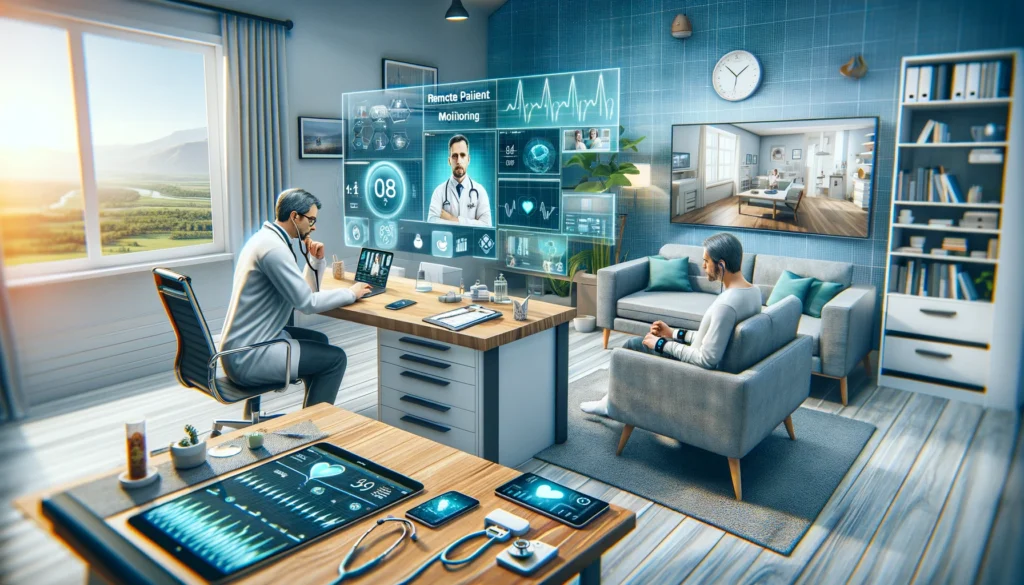
Conclusion
FAQ on Remote Patient Monitoring (RPM)
What is Remote Patient Monitoring (RPM)?
Remote Patient Monitoring is a method of healthcare delivery that uses technology to monitor patients’ health outside of traditional clinical settings. This could mean tracking from home, work, or while on the move.
How does Remote Patient Monitoring work?
Patients collect health data by using blood pressure cuffs, glucose monitors, or wearable fitness trackers. This data is then sent electronically to healthcare providers for analysis and, if necessary, follow-up actions.
What kind of health data can Remote Patient Monitoring?
RPM can track various health data, including heart rate, blood pressure, glucose levels, oxygen levels, weight, and even sleep patterns.
Who can benefit from RPM?
Anyone can benefit from RPM, especially patients with chronic conditions, those undergoing post-surgical recovery, or the elderly who require continuous monitoring.
